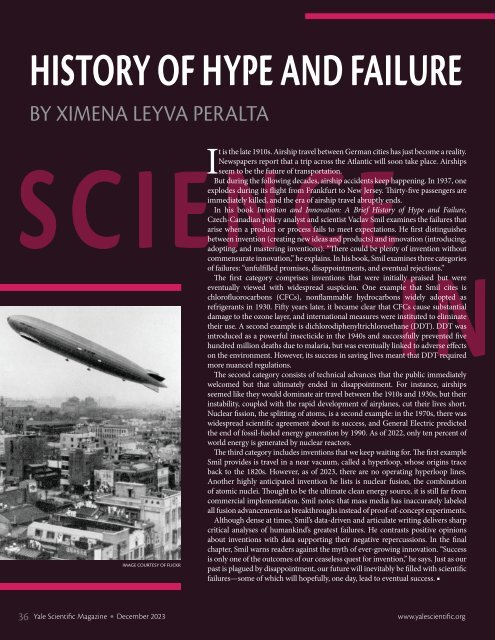YSM Issue 96.4
You also want an ePaper? Increase the reach of your titles
YUMPU automatically turns print PDFs into web optimized ePapers that Google loves.
HISTORY OF HYPE AND FAILURE<br />
BY XIMENA LEYVA PERALTA<br />
SCIENCE<br />
IN<br />
IMAGE COURTESY OF FLICKR<br />
It is the late 1910s. Airship travel between German cities has just become a reality.<br />
Newspapers report that a trip across the Atlantic will soon take place. Airships<br />
seem to be the future of transportation.<br />
But during the following decades, airship accidents keep happening. In 1937, one<br />
explodes during its flight from Frankfurt to New Jersey. Thirty-five passengers are<br />
immediately killed, and the era of airship travel abruptly ends.<br />
In his book Invention and Innovation: A Brief History of Hype and Failure,<br />
Czech-Canadian policy analyst and scientist Vaclav Smil examines the failures that<br />
arise when a product or process fails to meet expectations. He first distinguishes<br />
between invention (creating new ideas and products) and innovation (introducing,<br />
adopting, and mastering inventions). “There could be plenty of invention without<br />
commensurate innovation,” he explains. In his book, Smil examines three categories<br />
of failures: “unfulfilled promises, disappointments, and eventual rejections.”<br />
The first category comprises inventions that were initially praised but were<br />
eventually viewed with widespread suspicion. One example that Smil cites is<br />
chlorofluorocarbons (CFCs), nonflammable hydrocarbons widely adopted as<br />
refrigerants in 1930. Fifty years later, it became clear that CFCs cause substantial<br />
damage to the ozone layer, and international measures were instituted to eliminate<br />
their use. A second example is dichlorodiphenyltrichloroethane (DDT). DDT was<br />
introduced as a powerful insecticide in the 1940s and successfully prevented five<br />
hundred million deaths due to malaria, but was eventually linked to adverse effects<br />
on the environment. However, its success in saving lives meant that DDT required<br />
more nuanced regulations.<br />
The second category consists of technical advances that the public immediately<br />
welcomed but that ultimately ended in disappointment. For instance, airships<br />
seemed like they would dominate air travel between the 1910s and 1930s, but their<br />
instability, coupled with the rapid development of airplanes, cut their lives short.<br />
Nuclear fission, the splitting of atoms, is a second example: in the 1970s, there was<br />
widespread scientific agreement about its success, and General Electric predicted<br />
the end of fossil-fueled energy generation by 1990. As of 2022, only ten percent of<br />
world energy is generated by nuclear reactors.<br />
The third category includes inventions that we keep waiting for. The first example<br />
Smil provides is travel in a near vacuum, called a hyperloop, whose origins trace<br />
back to the 1820s. However, as of 2023, there are no operating hyperloop lines.<br />
Another highly anticipated invention he lists is nuclear fusion, the combination<br />
of atomic nuclei. Thought to be the ultimate clean energy source, it is still far from<br />
commercial implementation. Smil notes that mass media has inaccurately labeled<br />
all fusion advancements as breakthroughs instead of proof-of-concept experiments.<br />
Although dense at times, Smil’s data-driven and articulate writing delivers sharp<br />
critical analyses of humankind’s greatest failures. He contrasts positive opinions<br />
about inventions with data supporting their negative repercussions. In the final<br />
chapter, Smil warns readers against the myth of ever-growing innovation. “Success<br />
is only one of the outcomes of our ceaseless quest for invention,” he says. Just as our<br />
past is plagued by disappointment, our future will inevitably be filled with scientific<br />
failures—some of which will hopefully, one day, lead to eventual success. ■<br />
T<br />
S<br />
36 Yale Scientific Magazine December 2023 www.yalescientific.org

















